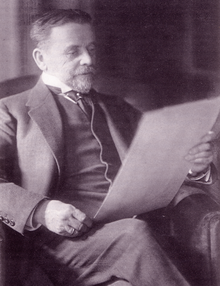Ludwig Hoffmann (architect)
Ludwig Hoffmann | |
|---|---|
 Ludwig Hoffmann | |
| Born | Ludwig Ernst Emil Hoffmann 30 July 1852 |
| Died | 11 November 1932 (aged 80) Berlin |
| Nationality | German |
| Occupation | Architect |
| Awards | Honorary citizen of Berlin |
Ludwig Ernst Emil Hoffmann (30 July 1852 – 11 November 1932) was a German architect and was one of the most famous architects of Berlin.
Life and career[]



Ludwig Hoffmann was born in Darmstadt and educated at the Kunstakademie Kassel (Kassel Academy of Art) and the Bauakademie (Academy of Architecture) in Berlin.[1] In 1879, after passing the first state examination, Hoffmann began working for the government of Berlin as a construction foreman under Franz Heinrich Schwechten.[2][3] His architectural career began in 1880 when he and , both unknowns, won the competition to design the Supreme Court building in Leipzig against 118 other entries.[4][5][6][7] In 1895, the year it was completed, he returned to Berlin and that June married Marie Weisbach, a banker's daughter.[7][8]
In 1896, Hoffmann became Stadtbaurat—director of urban planning and construction—for Berlin.[6] He served for 28 years until 1924[9] (mandatory retirement age being 72) and is now regarded as the most important holder of the position.[7]
Under his leadership 111 facilities were built, including over 300 buildings. He designed the new administration building for the city of Berlin, now known as the Altes Stadthaus (1902—1911).[10] He designed the Märkisches Museum (1899—1904), the museum of Berlin and the Mark Brandenburg.[6][11] With Alfred Messel, he designed the built version of the Pergamon Museum on Museum Island (1910—1930).[7][12] In addition he designed bridges, fountains, public baths, schools of every kind, orphanages, hospital complexes, cemeteries, private villas, and apartment buildings.[6][7] In his memoirs, he describes the long history of work on the Märchenbrunnen (fountain of fairy tales) for the Volkspark Friedrichshain, the first public park in Berlin.[13] Hoffmann had a significant impact on the urban development of Berlin both through his own designs and as a judge for many architectural competitions, although some of his projects were not constructed due to the outbreak of World War I, many were destroyed in World War II, and others were later demolished.[7] An archive of many of his designs is kept at the Architecture Museum of the Berlin Institute of Technology.
Honors and criticism[]
In 1906 Ludwig Hoffmann was awarded the title of Privy Councillor and an honorary doctorate from the Technische Universität Darmstadt. In the same year he was elected to membership of the Prussian Academy of Arts.[14][15] In 1917 he received a second honorary doctorate, from the Vienna University of Technology.[15] Upon his retirement in 1924 he was awarded honorary citizenship of Berlin.[9] A primary school in Friedrichshain (which he built), a hospital in Pankow, a bridge in Moabit, and a street in the Sellerhausen section of Leipzig bear his name.
Hoffmann's work was long out of favor for its historicism, but is now recognized as an important part of the effort to accommodate Berlin's rapid growth prior to World War I. As early as 1956, Ludwig Mies van der Rohe admitted he had been wronged.[16]
References[]
- ^ Hoffmann 1983, p. 30.
- ^ Reichhardt & Schäche 1986, p. 12.
- ^ Hoffmann 1983, p. 55.
- ^ Reichhardt & Schäche 1986, p. 116.
- ^ Topfstedt 2001, p. 1.
- ^ a b c d N. 1904–1926.
- ^ a b c d e f Zajonz 2002.
- ^ Viergutz 2001, p. 83.
- ^ a b Reichhardt & Schäche 1986, p. 61.
- ^ Hoffmann & Stahl 1914, pp. viii–xi.
- ^ Hoffmann & Stahl 1914, pp. xi–xiii.
- ^ Hoffmann 1983, p. 43.
- ^ Hoffmann 1983, pp. 154–60.
- ^ Dehio, Bollé & Badstübner-Gröger 2000, p. 32.
- ^ a b Reichhardt & Schäche 1986, p. 95.
- ^ "Ja, ja, der Hoffmann, dem haben wir alle unrecht getan!": quoted in Zajonz (2002)
Bibliography[]
- Dehio, Georg; Bollé, Michael; Badstübner-Gröger, Sibylle, eds. (2000). Handbuch der deutschen Kunstdenkmäler Berlin (in German) (2nd ed.). Munich: Deutscher Kunstverlag. ISBN 978-3-422-03071-8.
- Döhl, Dörte (2004). Ludwig Hoffmann. Bauen für Berlin 1896—1924 (in German). Tübingen: Wasmuth. ISBN 978-3-8030-0629-5.
- Hoffmann, Ludwig (1983). Schäche, Wolfgang (ed.). Lebenserinnerungen eines Architekten. Bauwerke und Kunstdenkmäler von Berlin Beiheft (in German). 10. Berlin: Mann. ISBN 978-3-7861-1388-1.
- Hoffmann, Ludwig; Stahl, Fritz (1914). Ludwig Hoffmann. Berliner Architekturwelt Sonderhefte (in German). 14. Berlin: Ernst Wasmuth. OCLC 4320395.
- N., G—g (1904–1926). "Hoffmann, Ernst Ludwig Emil". Nordisk familjebok (in Swedish). Project Runeberg.
- Reichhardt, Hans J.; Schäche, Wolfgang, eds. (1986). Ludwig Hoffmann in Berlin: die Wiederentdeckung eines Architekten: eine Ausstellung des Landesarchivs Berlin, 11. November 1986 bis 27. Februar 1987. Ausstellungskataloge des Landesarchivs Berlin (in German). 5. Berlin: Transit. ISBN 978-3-88747-033-3.
- Topfstedt, Thomas (2001). "Das Reichsgerichtsgebäude in Leipzig—vom Entwurf zum ausgeführten Bau". In Schmidt-Recla, Adrian; Schumann, Eva; Theisen, Frank (eds.). Sachsen im Spiegel des Rechts: ius commune propriumque (in German). Cologne: Böhlau. pp. 1–8. ISBN 978-3-412-07301-5.
- Viergutz, Volker (2001), "Das hätten wir in der Brüderstraße uns auch nicht träumen lassen. Anmerkungen zur Freundschaft von Ludwig Hoffmann und Alfred Messel", Berlin in Geschichte und Gegenwart. Jahrbuch des Landesarchivs Berlin, p. 83, ISBN 978-3-7861-2414-6
- Zajonz, Michael (July 30, 2002). "Meister aller Klassen: Alleskönner: Eine Ausstellung ehrt Berlins bedeutendsten Stadtbaurat Ludwig Hoffmann zum 150. Geburtstag". Der Tagesspiegel (in German). (CAPTCHA)
Further reading[]
- Feustel, Jan (1994). Spaziergänge in Friedrichshain. Berlinische Reminiszenzen (in German). 64. Berlin: Haude & Spener. ISBN 978-3-7759-0357-8.
External links[]
 Media related to Ludwig Hoffmann at Wikimedia Commons
Media related to Ludwig Hoffmann at Wikimedia Commons- Sketches, plans, and drawings of works by Ludwig Hoffmann, Architecture Museum, Technical University of Berlin (in German)
- Biography of Ludwig Hoffmann, Bundesverwaltungsgericht (in German)
- Ludwig Hoffmann biography, selected works, Projekt Baerwaldbad (in German)
- 1852 births
- 1932 deaths
- 19th-century German architects
- Architects from Berlin
- 20th-century German architects
- Recipients of the Pour le Mérite (civil class)